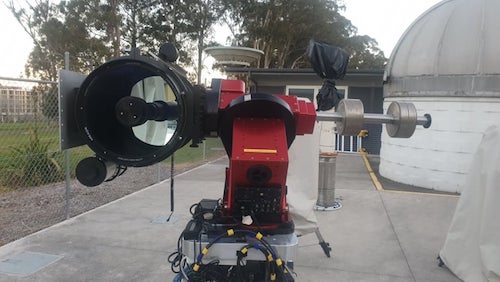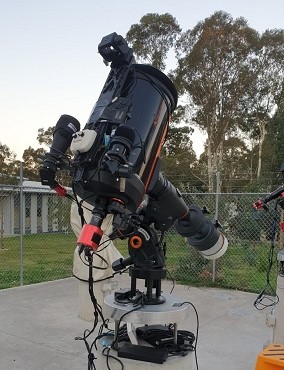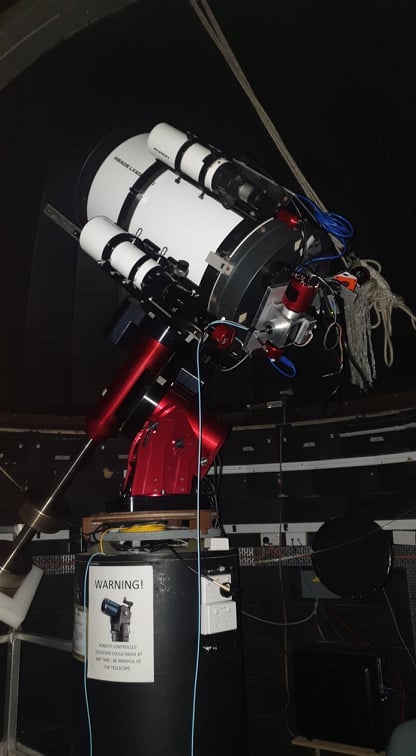Space Travels - All Things Planets - episode three
Your gateway to exploring our magnificent universe.
The Macquarie University Astronomical Observatory is back with episode 3 of MQ Space Travels!
For Episode 3, we bring to you “All Things Planets” with astronomer and science communicator Dr. Ángel R. López-Sánchez @El_Lobo_Rayado, from Australian Astronomical Optics (MQ-AAO) and the Department of Physics and Astronomy at Macquarie University, and hosted by our very own Dr. Devika Kamath @DrDevikaKamath.
Our Universe is full of planetary systems. Nevertheless, our Solar System is unique since it is the only one known, so far, to host “life” as we know it. Come join us for an evening of “All Things Planets”, as we explore our marvellous Solar System - from the craters and seas on our Moon, to the cocktail of gases in the rings of Saturn, to the storms brewing up in Jupiter, and much more.
Follow the hashtag #MQSpaceTravels on all the socials and to ask questions.
Streaming live on Friday 17 September at 7pm AEST: https://fb.me/e/1ibAXSss3
For episode three we are using the following equipment:
Telescope: 12” Meade LX200 SCT 
Optics: TeleVue 2x Barlow
Filters: filter wheel (L:R:G:B:IR742:IR807:CH4)
Camera: ZWO ASI462MC
The 12’’ Meade LX200 Schmidt Cassegrain telescope is an optical reflecting telescope located at the Macquarie University Astronomical Observatory. The main reflecting mirror is 12 inches (30.5cm) in diameter. This allows us to look at the night sky through the visible wavelength, as our eyes see it. This telescope used to live in one of the main domes at the observatory and has been used extensively for outreach sessions and astrophotography over many years. Nowadays the 12’’ Meade is mounted on a concrete pier outside the domes alongside many other telescopes.
In this episode, the 12’’ Meade will image Venus, Jupiter, Saturn, and Neptune using the ZWO ASI462MC camera. The images will be adjusted using a TeleVue 2x Barlow that magnifies the image and a filter wheel that accentuates certain wavelengths of light coming from the object. The set filters are: luminance (L) filter, red/green/blue filter (RGB) , infrared (IR) filters, and a methane (CH4) filter.
Telescope: 12” Meade LX200 SCT
Optics: N/A
Filters: Star Analyser 200
Camera: ZWO ASI183MC
The 12’’ Meade will also be used with the Star Analyser 200. The Star Analyser is a filter with a grating that allows the light passing through to be split into a spectra (like a rainbow). This episode will look at Neptune through the Star Analyser and will be imaged with the ZWO ASI183MC camera.
Telescope: 9.25” Celestron XLT SCT 
Optics: f/6.3 reducer
Filters: N/A
Camera: ZWO ASI183MC-cooled
The 9.25’’ Celestron XLT Schmidt Cassegrain Telescope is another optical reflecting telescope located at the Macquarie University Astronomical observatory, mounted on a pier next to the 12’’ Meade. The main reflecting mirror is 9.23 inches (23.5cm) in diameter. This telescope, unlike the 12’’ Meade, was previously used for off-campus outreach sessions and has travelled across NSW to be used for general public, school group, and scout group sessions. More recently, and due to the effects of COVID-19, the 9.25’’ Celestron has been used for astrophotography and live stream sessions.
In this episode, the 9.25’’ Celestron will image Venus, the Moon, Jupiter, Saturn, and Neptune. Finishing things off with a (stellar) bang, this telescope will also image the planetary nebula, the Helix Nebula, nicknamed “The Eye of God”. These objects will be imaged using a ZWO ASI183MC-cooled camera and adjusted using a f/6.3 focal reducer. This gives us a wider field of view, allowing us to see more of the object in one frame, including being able to view the moons of several planets, such as Jupiter and Saturn.
Telescope: 16’’ Meade LX200 SCT 
Optics: f/6.3 reducer
Filters: N/A
Camera: ZWO ASI1600MM-pro
The 16’’ Meade LX200 Schmidt Cassegrain telescope is an optical reflecting telescope located at the Macquarie University Astronomical Observatory. The main reflecting mirror is 16 inches (40.6cm) in diameter. This telescope currently lives in one of the main domes at the observatory and has been used extensively for outreach sessions and astrophotography over many years. In this episode, the 16’’ Meade will image the Moon with a ZWO ASI1600MM-pro camera and f/6.3 focal reducer.